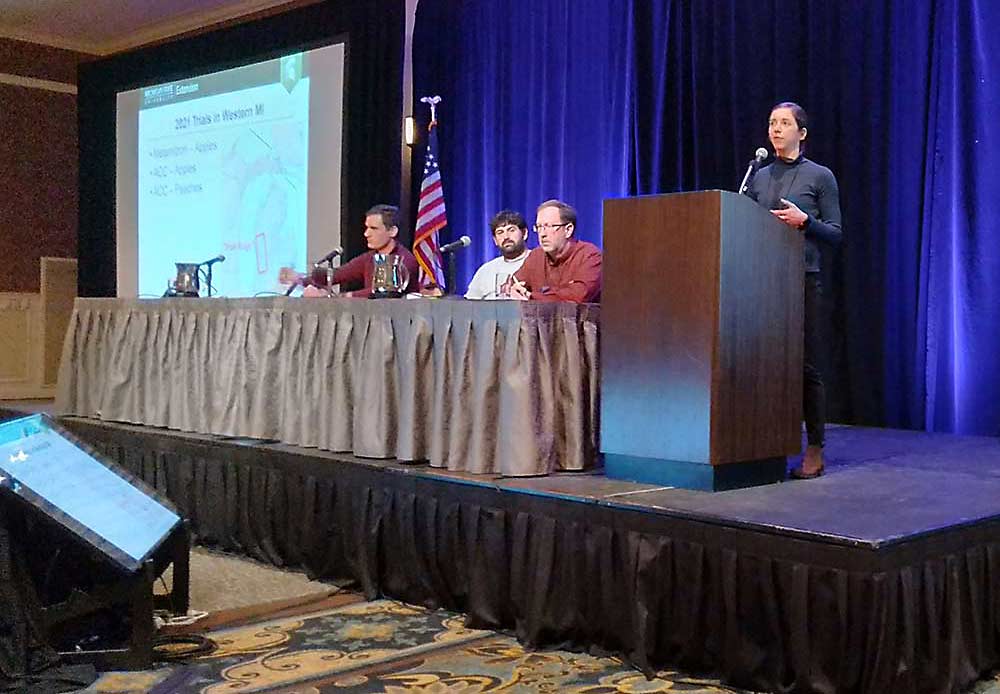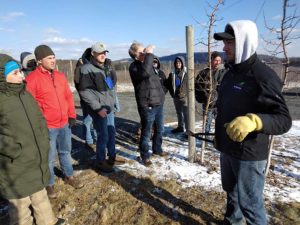
The third and final day of the International Fruit Tree Association’s 65th Annual Conference and Tours, held in Hershey, Pennsylvania, was a full day of educational sessions.
Penn State University pomology professor Jim Schupp talked rootstocks for future peach production. He said peaches are the second most important tree fruit in Pennsylvania, after apples, and very important for early-season cash flow.
Low yields are a challenge, however, and production efficiency lags behind apples. Current low-density peach systems are slow to start cropping, with suboptimal crop potential.
Peaches also are labor intensive, with very dense canopies and excessively vigorous regrowth. The shade lowers fruit quality and color, and typical vase growing systems are not compatible with mechanization, he said.
In other words, Pennsylvania peach growers are not set up for the future, and they need to make some changes. Among other things, they need higher densities for earlier and larger yields, narrow canopies and size-controlling rootstocks.
One of the training systems Schupp recommended was Quad V, which splits the canopy into two narrow tree walls. The system increases yield and color and facilitates mechanization. It can better manage crop load, irrigation and fertilizer, too, Schupp said.
He said Bailey has been a good rootstock for precocity, productivity and size control. Controller 6, 7 and 8 have also shown promise as productive semidwarf rootstocks in his peach trials.
Schupp said dwarf peach trees need permanent support, such as trellises and posts.
“There is no such thing as a freestanding full dwarf tree in a commercial setting,” he said.
High-density peaches will not be the same as high-density apples: They’ll need somewhat wider spacings to get better fruit size, he said.
“We’re overdue for a sea change in peach tree production systems,” Schupp said.
Retired Rutgers University agricultural agent Win Cowgill led off the afternoon session, titled “PGRs, Biostimulants and Snake Oils.”
So, what makes a product real and not “snake oil”? Cowgill said good, replicated research from a third party is a good indicator. A company should be willing to put its products up to the test. What is not OK is a product that is only backed up by customer testimonials. If a product developer isn’t willing to invest money in testing and product development, there’s a good chance the product might be snake oil, he said.
Valent technical development specialist Poliana Francescatto opened a discussion about plant growth regulators by talking about ACC and ABA. ABA, abscisic acid, is a naturally-occurring plant hormone that promotes thinning in apples and especially in pears. It can be used in organic production and has potential for bitter pit control in apples.
ABA, which promotes leaf senescence and abscission, could be used to partially defoliate apple trees to promote fruit color, she said.
ACC, marketed as Accede, is the first registered thinner in stone fruit that’s based on a naturally-occurring compound. The immediate precursor to ethylene, ACC can be applied from pink bud to petal fall in stone fruit and could be a late/rescue thinner in apples. ACC is a more reliable fruit thinner than ethephon at high temperatures, and it does not cause gummosis in stone fruit, Francescatto said.
Michigan State University Extension apple production specialist Anna Wallis said a first application of Accede in peaches at 20 percent bloom and a second application at 100 percent bloom can result in a significant reduction in fruit, cutting follow-up hand thinning almost by half.
As an apple thinner, Accede works best as part of a season-long thinning program. In Michigan trials, Accede performed best on apples in the “rescue” thinning window, when fruitlets are about 20 millimeters in diameter, Wallis said.
—by Matt Milkovich







Leave A Comment